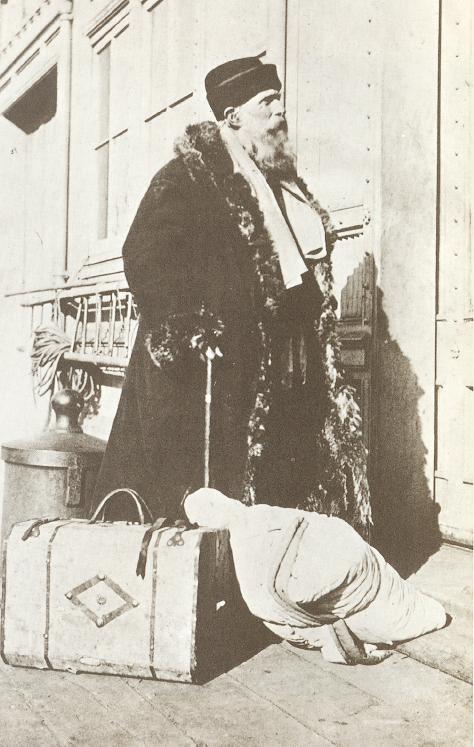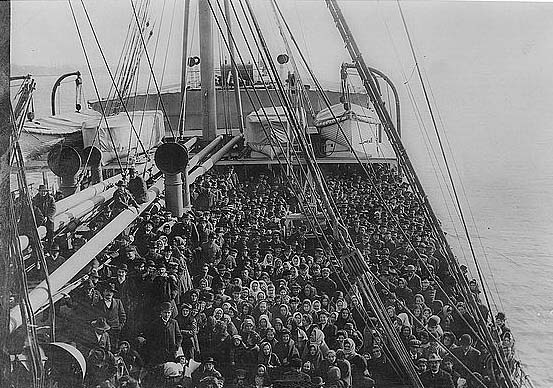|
|||
|
As the security situation of the Jews inside the Russian Empire worsened, they began to emigrate to other countries in record numbers. Pobedonostsev, one of the major protagonists of anti-Jewish sentiment in Russia at the time, is said to have proposed that the solution to the Jewish problem was for a third to emigrate, a third to assimilate and a third to die (Wheatcroft). Naturally, most opted for the former. According to Prof. Ronald Stockton of the University of Michigan-Dearborn, who posted an essay on the Internet entitled “The Jewish Situation and Jewish Nationalism” (dated November, 1993), from 1830 to 1870 between 1,000 and 4,000 Jews per year left Eastern Europe. From 1871 to 1880 between 8,000 and 10,000 fled annually, mostly from the Russian Empire. In the period 1881-1890, the figure rose to 50,000 to 60,000, mainly as a result of the first wave of Russian pogroms. From 1901 to the outbreak of World War I in 1914, when the pogroms were at their worst, 150,000-160,000 Jews per year escaped from Eastern Europe, mostly from the Pale of Settlement.
Jewish Russian immigrant arrives in the U.S. Prof. Stockton claims that at the height of the emigration wave, between 1880 and 1920, about 2.5 million Jews left Eastern Europe, of which 2 million went to the United States. Most American Jews, including the Grossmans, can trace their origins to the great flight of these years. At one point the United States government set up what was called the Galveston Plan, which enabled more than 10,000 Jewish immigrants, mostly from Ukraine, to immigrate to the country through Galveston, Texas. From there they settled throughout the Midwest. However, most Jews entered the United States from the East Coast, especially Ellis Island.
Shipload of immigrants arrives in New York In addition, another 200,000 Jews went to Great Britain, 100,000 to Canada, 40,000 to South Africa and several thousand to Palestine. After more than a thousand years of abuses under tyrannical European regimes most of the Jewish emigrants chose to abandon the continent once and for all. In fact, only 300,000 resettled in continental Europe, less than eleven percent of the total. Brody, a
town located on the frontier between the Austro-Hungarian Empire and the
Pale of Settlement, became the principal gateway through which the
gigantic exodus of Jews from the Pale was channeled, beginning in 1880. It is likely that many emigrants from Sudilkov passed though
Brody as well. According to
an 1882 pre-Revolutionary map of the western Russian Empire , Sudilkov was
situated next to the railroad tracks which led directly Many Sudilkover Jews chose the United States as their final destination. The myth of “the land of freedom and opportunity” where Jews could practice their religion without fear of persecution reached the ears of our ancestors and filled them with hope. Without doubt they heard stories and legends of the successes of those who made the journey before them. Correspondence from friends or relatives who had arrived safely in New York or Boston must have emboldened them to follow in their footsteps. Those who decided to make the voyage sold whatever they had, converting what was of value into hard currency, such as jewelry, watches, gold and silver objects, home furnishings and property. They made one last visit to the synagogue, received the blessing of the rabbi, bid farewell to everyone they knew—to their entire world—and set off on their way, never to return. In most cases men left their families behind, expecting to earn enough money overseas to send for their wives, children and other relatives later. The first émigrés from Sudilkov to America probably had no particular destination city in mind. At most they had seen a postcard or heard of New York, Philadelphia or some other city, the name of which they could hardly pronounce! However, towards the end of the nineteenth century Sudilkovers fleeing to the United States specifically sought out relatives who had departed before them. Families and entire villages reconstituted themselves in the New World, forming new communities from the remnants of the past. In the course of my research on the Internet I was able to contact several descendants of Jews who had come to Boston, New York and Chicago from Sudilkov. From them I learned a few details of how immigrants from our ancestral town arrived in the United States. The grandson of a Sudilkover named Sine Weiner told me that Sine was a 38-year-old shoemaker when he left Sudilkov for the port of Hamburg in the early twentieth century. From there he paid for a passage to Boston on the SS. Palatin. In 1899, some years earlier, Sine’s relatives Dora and Charles Weiner made the same voyage on a ship called the Pretoria. Albert Sherman, Vice Chancellor of the University of Massachusetts Medical School in Worcester, informed me via Email (Dec. 12, 1998) that his mother immigrated to Boston from Sudilkov in about 1916, when she was only a teen. Her last name was “Karrassik”, but it was changed to “Karass” upon arrival. Her sister, who also hailed from there, is now 95 years old, but unfortunately has no memories of the town. Sherman informed me that there was a very active Sudilkover Society in Boston (as well as New York), and that there are several Sudilkover cemeteries in both cities. In a subsequent Email (Dec. 13, 1998) he claims that “Sudilkov and surrounding places were actually the birthplaces of the major Chassidic courts.” Thus, Jewish immigrants from the Sudilkov region tended to gather in Boston and New York in order to “to be near the Chassidic communities that were transplanted from the ‘Old Country’ to the U.S.” Sherman has been conducting his own research on Sudilkov and claims to have found some interesting references at the Museum of the Diaspora (Beir Hatefutsot at Tel Aviv University) and at the Valley of the Lost Communities memorial at Yad Vashem, Israel. Another descendant of Sudilkovers, Bernard S. Schreft, wrote me (Dec. 12, 1998) that his grandfather came alone from Sudilkov to Boston in about 1912, and was not able to bring his family over until after World War I. Yet another such descendant, Gerald Silverstein, wrote me (Dec. 14, 1998) that his mother’s family, the Lerners, together with their cousins, the Rutfields, came to the Boston area from Sudilkov in the late 1890’s and in 1901. He claims that his family left the Russian Empire because of the pogroms. In fact, a brother of his grandfather was killed trying to escape. According to him, the Jewish Cemetery Association of Massachusetts manages a cemetery in Everett which has a section named “Sudilkov”, founded by people from that town and run by the Sudilkov Cemetery Society, 232 Fuller Street, Everett, MA 02149. In Chicago, Illinois there exists to this day a Sudilkov Sick Support Society, a volunteer group for care of the elderly. I was told that the group publishes an anniversary journal. One member, Jacob Wine, apparently was born in Sudilkov, but I do not know whether he is still living, nor would I know how to contact him if he were. In Chicago there is also an organization called the Sudilkov-Shepetowka Relief Society. Its address is Waldhein Cemetery, 1400 Despaines Avenue, Forest Park, IL 60130-2598. It is evidently connected in some way to the Jewish cemetery in which several ex-residents of Sudilkov are buried, including some members of our relatives! As for the Grossmans and their kinsmen the Biermans, after their arrival in the United States they chose not to settle in any of the great cities of the East Coast. They also skipped past Chicago, the economic powerhouse of the Upper Midwest. For reasons which to many of us are shrouded in mystery they selected Minneapolis, Minnesota, the ice and mosquito capital of North America, as their final destination! I will attempt to unravel this mystery in a later chapter. Clearly the Jews of Eastern Europe had good reason to pack up and leave the continent. In the course of only a few decades, sustained persecution drove millions of them from their ancestral towns and villages. For those who could afford the voyage, the United States was the destination of choice. The development of large, vigorous Jewish communities in American cities, and the transplantation there of major Jewish religious and intellectual figures, increased the volume and pace of emigration. In the years preceding the outbreak of World War I, East European Jews were flooding into American ports at an incredible rate. Thus, the Diaspora came to be extended across the Atlantic Ocean, as Jews took refuge as far away as the United States. Yet despite the mass departure of their brethren, many Jews remained in their shtetls, either because they were too poor or unfit to leave, or because they stubbornly refused to abandon what had been theirs for centuries. They continued to hope and pray that their luck would somehow change. Sadly, the unfortunate millions who remained in western Russian through the post-revolutionary era found themselves trapped there. They were to suffer terrible ordeals during the first wave of Stalinist purges. And yet the bleak period between the world wars was a happy interlude compared to the weeks and months following the Nazi invasion of 1941, when barbarous crimes were committed against the Jews on an unimaginable scale. |


